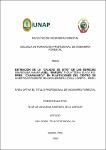Estimación de la “calidad de sitio” de las especies Simarouba amara aubl. “marupá” y Guatteria elata R.E. Fries. “carahuasca” en plantaciones del Centro de Investigaciones Jenaro Herrera (CIJH), Loreto – Perú.
Abstract
El presente estudio se desarrolló en el Centro de Investigaciones Jenaro
Herrera, ubicado en la Provincia de Requena, Distrito de Villa Jenaro Herrera,
Región Loreto. El objetivo fue estimar la “Calidad de Sitio” en plantaciones
forestales para dos especies promisorias: Simarouba amara Aubl. “marupá” y
Guatteria elata R. E. Fries “carahuasca” mediante la evaluación dasométrica de
783 árboles establecidos en 59 parcelas permanentes de control (42 PPC’s de
marupá y 17 de carahuasca), que incluye los parámetros: diámetro a la altura del
pecho (dap), altura total (ht), altura comercial (hc), tendencia y estado sanitario
de los árboles. Las parcelas están distribuidas en 15 plantaciones forestales del
tipo experimental silvicultural en diferentes sectores de la terraza alta en los
lugares denominados plantación campo abierto Laurent (2 plantaciones), el Piñal
(5 plantaciones), el Cañal (2 plantaciones), Colonias a campo abierto (2
plantaciones) y plantaciones en Fajas (4 plantaciones) las que representan la
variabilidad del sitio del área de influencia del centro de investigaciones. En cada
parcela se evaluaron factores físicos y químicos del suelo a dos profundidades
de 0-20 cm y de 20-40 cm, datos que sirvió de base para correlacionar el
crecimiento y la productividad de ambas especies en el área de influencia del
CIJH. Para estimar el comportamiento de la altura dominante con la edad se
aprovechó información histórica de ambas especies sobre mediciones
dasométricas multitemporales que se realizaron desde el año 1983 hasta la
actualidad, para tal efecto se empleó el modelo de Schumacher: Ln (H.dom) = a
+ b (1/E)K donde, Ln = logaritmo natural; H.dom = altura dominante; a y b =
coeficientes; k = constante. Para determinar la ecuación que estima el índice de
sitio con base en la edad y la altura dominante se utilizó el método de la curva
guía descrito por Hughell (1991) citado por Otárola (1996); finalmente,
despejando la altura dominante de las parcelas a diferentes edades se construyó
la familia de curvas anamórficas de ambas especies consideradas en el estudio.
La productividad de las plantaciones fue calculada con las ecuaciones de
RESUMEN
volúmenes desarrolladas para ambas especies por Otárola et al (2001 y 2002).
La ecuación de índice de sitio permitió clasificar las plantaciones forestales de
Simarouba amara y Guatteria elata en tres clases de sitio: alta (I), media (II) y
baja (III), cuyo ámbito fue definido por la desviación estándar. This study was developed at the Jenaro Herrera Research Center,
located in the Province of Requena, Villa Jenaro Herrera District,
Loreto Región. The objective was to estimate the "Site Quality" in
forest plantations for two promising species: Simarouba amara Aubl.
"marupá" and Guatteria elata R. E. Fries "carahuasca" by the
dasometric evaluation of 783 trees established in 59 permanent control
plots (42 PPC's of marupá and 17 carahuasca), which includes the
parameters: diameter at chest height (dap), total height (ht),
commercial height (hc), trend and health status of trees. The plots are
distributed in 15 forest plantations of the experimental forestry type in
different sectors of the high terrace in the places called plantation open
field Laurent (2 plantations), the Piñal (5 plantations), the Cañal (2
plantations), colonies in open field (2 plantations) and plantations in
Fajas (4 plantations) which represent the variability of the site of the
area of influence of the research center. In each plot, physical and
chemical factors of the soil were evaluated at two depths of 0-20 cm
and 20-40 cm, data that served as the basis for correlating the growth
and productivity of both species in the CIJH area of influence. To
estimate the behavior of the dominant height with age, historical
information of both species was used on multitemporal dasometric
measurements that were made from 1983 to the present day, for this
purpose the Schumacher model was used: Ln (H.dom) s a + b (1/E)K
where, Ln ' natural logarithm; H.dom - dominant height; (a) and (b)
coefficients; k ' constant. To determine the equation estimating the site
index based on age and dominant height, the guide curve method
described by Hughell (1991) cited by Otárola (1996) was used; Finally,
clearing the dominant height of the plots at different ages was built the
family of anamorphic curves of both species considered in the study.
Theproductivity of the plantations was calculated with the equations of
volumes developed for both species by Otárola et al (2001 and 2002).
The site index equation allowed the forest plantations of Simarouba
amara and Guatteria elata to be classified into three site classes: high
(I), mean (II), and low (III), the scope of which was defined by the
standard.
Collections
- Tesis [525]


